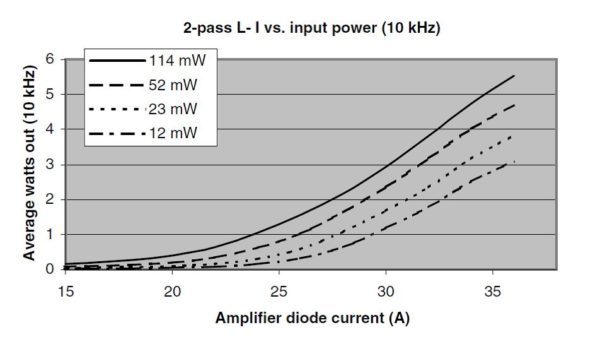
Passively Q-switched microchip solid-state lasers (microchip lasers) are convenient sources of short-pulse emission (0.5 to 1 ns) having high pulse energy (10’s of uJ) and near-diffraction-limited beam quality. Applications of microchip lasers can be extended significantly by increasing their pulse energy and average power using one or more amplifiers stages, but only if the amplifiers preserve the inherent beam quality and other desirable attributes of the microchip emission.
We have demonstrated that a 2-pass VHGM amplifier can increase the pulse energy and average power of a 1064 nm microchip oscillator to more than 500 uJ and 5W, respectively, while preserving the microchip laser’s beam quality and emission spectrum. The figure below shows average 1064 nm output power of the 2-pass amplifier vs. amplifier drive current (at a pulse rate of 10 kHz) and as a function of 1064 nm seed power injected into the 2-pass amplifier. Maximum 808 nm pump power in the amplifer was 40W. The 2-pass amplifier is well-saturated at 100 mW seed power considering that reducing seed power by a factor of 10 (to about 10 mW) results in less than a 2x reduction in amplifier output power.
A Faraday isolator is not needed at the output end of the 2-pass amplifier, as is often needed in other designs to separate the 2-pass-amplified beam from the input seed beam, thereby resulting in a more compact, more efficient, and lower cost MOPA system. More details are provided in JG Manni, Optics Communications 252:117-126 (2005).

Microchip laser oscillators are now commercially available that can generate 10 nJ pulse energy in a 200 ps pulse duration, and 4 nJ in a 100 ps pulse. (See www.batop.de) We plan to mate such microchip lasers to our 2-pass VHGM amplifiers and will be reporting our results on this web page.